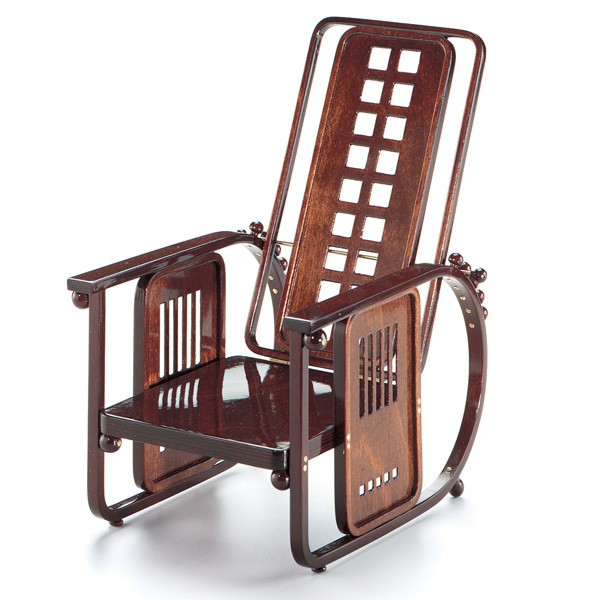skip to main |
skip to sidebar
The workshops designed interior spaces collaboratively, using a design philosophy of the "total work of art," or in German the "Gesamtkunstwerk." This idea of a Gesamtkunstwerk permeated the creative processes of the Werkstätte. They created projects collectively, and designed and fabricated everything for the interiors themselves, from silverware to upholstery. The Perhaps the most famous example of this creative process is the Palais Stoclet in Belgium, which was commissioned by Adolphe Stoclet and built between the years of 1905 to 1911. The building's rooms are designed so that the lines created by furniture and architectural elements are proportional to one another, and so that the materials and color palette feels unified. Additionally, shapes such as the square repeat throughout the entire building.
 Likewise, they believed in treating the materials in an honest fashion. Many pieces were made by staining wood black, and then rubbing white pigment into the grain. This was done to make the surface more interesting and lively. Hoffmann and the Wiener Werkstätte rejected the idea that wood should be stained for the sake of making it appear as if it was another kind of more expensive wood. They allowed their materials to stand on their own, becoming a motif in and of themselves.
Likewise, they believed in treating the materials in an honest fashion. Many pieces were made by staining wood black, and then rubbing white pigment into the grain. This was done to make the surface more interesting and lively. Hoffmann and the Wiener Werkstätte rejected the idea that wood should be stained for the sake of making it appear as if it was another kind of more expensive wood. They allowed their materials to stand on their own, becoming a motif in and of themselves.
Around the year 1895, there was a search for an autonomous, national, and modern style which would therefore break the historicizing approach that dominated Vienna for the past 60 years. Natives of the city felt that the historical approach was dishonest, and represented aspects of aristocratic and court culture which most of the public could not relate to. Otto Wagner was the first to publicize this negative reaction, and therefore helped it gain acceptance among a wider audience. As a result, he acted as the artistic father to architects and designers who implemented his ideas. However, among this group of followers came about two distinct groups. The first, led by Josef Hoffmann and Koloman Moser, was by far the larger of the two. This group revolved around Vienna's School of the Arts and Crafts, The Wiener Werkstatte, and the Vienna Secession. To realize modernism, the first group wanted to invent a new style, which would still fit within the realms of a traditional social system.
Josef Hoffmann:Was the founder of the Wiener Werkstätte in 1903. Josef Hoffmann was trained as an architect, but he made many different objects, including furniture. He is perhaps best remembered for his objects for the bent-wood industry. Most of these designs were designed to be mass produced. Some of his items are still in production today. His designs were considered very avant-garde for his time.
 (Hoffmann, Sitzmaschine
(Hoffmann, Sitzmaschine, 1905)
Koloman Moser:Moser was a founding member of the Wiener Werkstätte, along with Josef Hoffmann. He designed many of the printed materials for the Werkstätte, and Hoffmann helped him to realize his 2D designs as 3-dimensional objects of furniture. He eventually left in 1906, amidst financial difficulties. He concluded that the work being created by the WW was too varied and differed greatly from commissioner to commissioner.
 (Moser, Zebra Cabinet, 1904)
(Moser, Zebra Cabinet, 1904)
Dagobert Peche
Studied Architecture at the Academy of Fine Art, and after four years of freelancing, joined the Wiener Werkstätte. Dagobert joined the Wiener Werkstätte in 1915, during World War I. His work was more ornamental than the work of Moser and Hoffmann, because he came at a later time, when Viennese design was not quite as preoccupied with geometry.
 (Peche, Cabinet)
(Peche, Cabinet)



